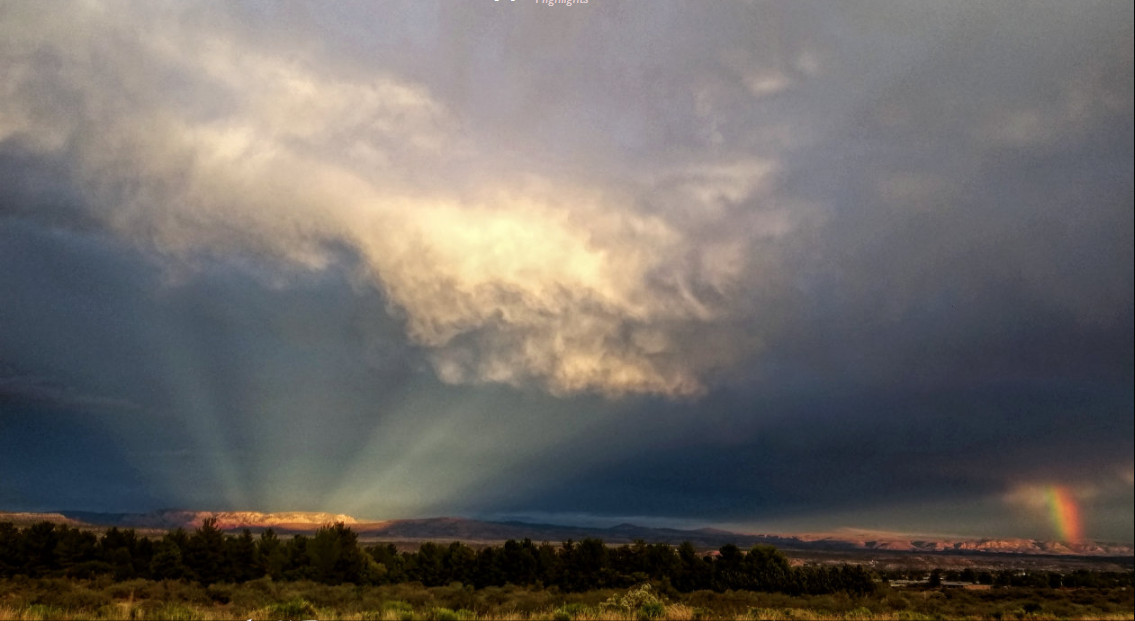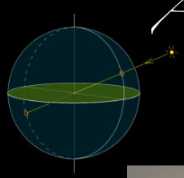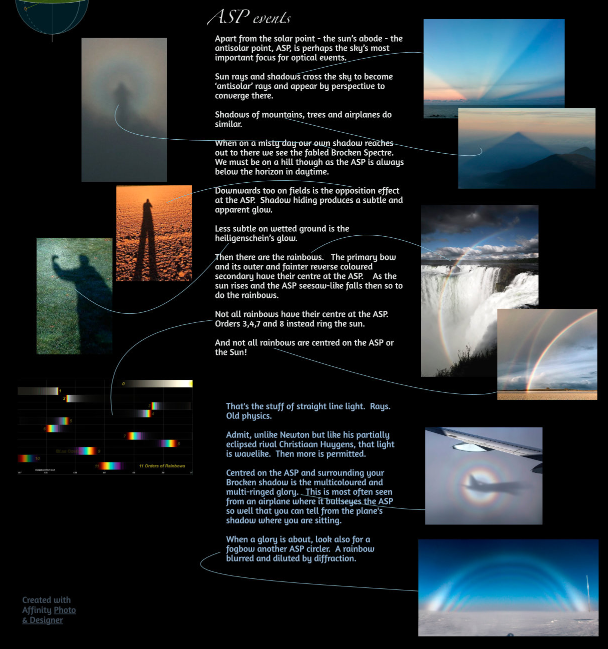The Antisolar Point
The Antisolar Point: Unveiling the Mysteries of the Sky
Have you ever looked up at the sky and wondered about the fascinating optical phenomena that occur? One such phenomenon is the Antisolar Point (ASP), which holds a significant place in the realm of atmospheric optics. While the solar point is where the sun resides, the ASP is the exact opposite point in the sky, directly opposite the sun. In this article, we will delve into the captivating world of the ASP and explore its various optical events.
Exploring ASP Events
Aside from being the sun's counterpart, the ASP serves as a focal point for numerous optical events in the sky. Rays and shadows from various objects cross the sky and converge at the ASP due to perspective. Mountains, trees, and even airplanes cast shadows that also converge at this point, creating a mesmerizing sight.
One remarkable phenomenon that occurs at the ASP is the Brocken Spectre. On misty days, when our own shadow extends towards the ASP, we can witness this enchanting spectacle. However, it's important to note that to observe the Brocken Spectre, one must be situated on a hill as the ASP is always below the horizon during daytime.
Another intriguing occurrence at the ASP is the opposition effect. When shadows are concealed, either by hiding or by wetted ground, a subtle yet apparent glow emerges. This phenomenon can be observed on fields and is caused by the interaction of light with water droplets or other reflective surfaces.
Rainbows and Their Connection to the ASP
Rainbows, those ethereal arcs of colors, also have a special connection to the ASP. The primary bow and its fainter, reverse-colored secondary bow both have their center at the ASP. As the sun rises and falls, causing the ASP to move in a see-saw motion, the position of the rainbows also changes accordingly.
However, not all rainbows are centered on the ASP or the sun. Some rainbows, known as higher-order rainbows, form rings around the sun instead. These include the third, fourth, seventh, and eighth order rainbows, which encircle the sun rather than converging at the ASP.
But let's dive deeper into the nature of light itself. While traditional physics views light as composed of straight-line rays, considering it as a wave allows for more possibilities. If we embrace the wave-like nature of light, we can uncover even more fascinating optical phenomena associated with the ASP.
The Glory and Fogbow: More Wonders of the ASP
When viewing your own Brocken shadow at the ASP, you may witness a captivating phenomenon called the glory. This multicolored and multi-ringed glow is often seen from airplanes, where it perfectly aligns with the ASP. In fact, by observing the position of the plane's shadow, you can determine where you are seated on board.
Accompanying the glory, you may also spot a fogbow, another optical marvel that circles the ASP. Unlike a traditional rainbow, the fogbow appears blurred and diluted due to diffraction. Its ethereal beauty adds to the enchantment of the ASP and further showcases the intricate interplay between light and atmospheric conditions.
In conclusion, the Antisolar Point is a captivating focal point in the sky that unlocks a world of optical wonders. From converging rays and shadows to mesmerizing rainbows and ethereal glories, the ASP reveals the intricate nature of light and its interactions with our atmosphere. So, next time you find yourself gazing at the sky, take a moment to appreciate the beauty and mysteries that unfold around the Antisolar Point.

ASP
Imaged in Arizona by Taavi Babcock. Rays from the dark sky converge below distant hills at left. The hills are brightly sunlit telling that we are looking away from the sun. They are anticrepuscular or, more properly, antisolar rays. They converge towards the "antisolar point, ASP" directly opposite the sun. At right a stub of rainbow adds colour. Hard to judge here but it's also centred at the ASP.

ASP events
Apart from the solar point- the sun's abode - the antisolar point, ASP, is perhaps the sky's most important focus for optical events..
Sun rays and shadows cross the sky to become 'antisolar' rays and appear by perspective to
converge there.
Shadows of mountains, trees and airplanes do similar.
When on a misty day our own shadow reaches out to there we see the fabled Brocken Spectre. We must be on a hill though as the ASP is always below the horizon in daytime.
Downwards too on fields is the opposition effect at the ASP. Shadow hiding produces a subtle and apparent glow.
Less subtle on wetted ground is the heiligenschein's glow.
Then there are the rainbows. The primary bow and its outer and fainter reverse coloured secondary have their centre at the ASP. As the sun rises and the ASP seesaw-like falls then so to do the rainbows.
Not all rainbows have their centre at the ASP. Orders 3,4,7 and 8 instead ring the sun.
And not all rainbows are centred on the ASP or the Sun!
That's the stuff of straight line light. Rays. Old physics.
Admit, unlike Newton but like his partially eclipsed rival Christiaan Huygens, that light
is wavelike. Then more is permitted.
Centred on the ASP and surrounding your Brocken shadow is the multicoloured and
multi-ringed glory. This is most often seen from an airplane where it buttseyes the ASP
so well that you can tell from the plane's shadow where you are sitting.
When a glory is about, look also for a fogbow another ASP circler. A rainbow
blurred and diluted by diffraction.

Note: this article has been automatically converted from the old site and may not appear as intended. You can find the original article here.
Reference Atmospheric Optics
If you use any of the definitions, information, or data presented on Atmospheric Optics, please copy the link or reference below to properly credit us as the reference source. Thank you!
-
<a href="https://atoptics.co.uk/blog/the-antisolar-point/">The Antisolar Point </a>
-
"The Antisolar Point ". Atmospheric Optics. Accessed on November 26, 2024. https://atoptics.co.uk/blog/the-antisolar-point/.
-
"The Antisolar Point ". Atmospheric Optics, https://atoptics.co.uk/blog/the-antisolar-point/. Accessed 26 November, 2024
-
The Antisolar Point . Atmospheric Optics. Retrieved from https://atoptics.co.uk/blog/the-antisolar-point/.